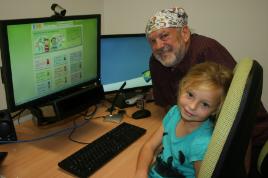Eye tracker strengthens research vision
Published on 06 April, 2011
CQUniversity Noosa's reputation as a burgeoning research hub has been enhanced with a new world-class eye tracking facility.
The $70,000 facility was developed at CQUniversity Noosa's Learning & Teaching Education Research Centre (LTERC) by Associate Professors Mike Horsley and Lorna Moxham, and is one of only four worldwide to use cutting-edge technology to detect, record and analyse how learners regulate their own learning in e-learning.
LTERC Director Associate Professor Horsley said the facility would be used to undertake innovative research aimed at the highest level international journals.

Azalia Frisby pictured, with Associate Professor Mike Horsley is one of the first students to use the eye tracker which could revolutionise the way we approach the production of learning materials in classrooms."Because we can test anything that can be shown on a screen, there are numerous research applications for the eye tracker," he said.
"One of the first big studies planned with my nursing colleagues Mark Broadbent, Melanie Birks and Lorna Moxham is a measurement of nurses' responses and understanding of electrocardiographs - something which has never been done before."
"We can test how accurately and efficiently nurses are interpreting important pieces of information and use the results to refine teaching methods.
"Similarly, we're already one of the first to use this eye tracker technology in analysing how people interpret X-rays."
Largely used for commercial market research, Associate Professor Horsley said the eye tracker was also a valuable tool for measuring the effectiveness of educational materials.
"There is exciting potential for exploring how students read educational texts both in and out of the classroom," he said.
"This can help us design better texts and educational websites and improve teaching and instruction.
"It could revolutionise how we approach the production of learning materials and could also directly feed back in the way we deliver the variety of Learning Management (Teaching) courses we have at CQUniversity."
Associate Professor Horsley said the eye tracker facility would enhance the Goodchap Road Research Centre's reputation for pioneering social science research.
"There are several types of eye tracking devices but this is the state-of-the-art model," he said.
"The facility itself is part of a larger strategy at the LTERC towards performing new and innovative research.
"I can see our results having a global reach and international implications."
The Swedish-designed eye tracker detects a subject's gaze duration, position, movement and frequency, while accompanying software maps and plots the data according to researcher's needs.
Associate Professor Horsley said one of the big advantages was not having to rely on asking subjects to recall their reactions during testing.
"This technology eliminates recall errors that could be the result of a poor memory or social factors," he said.
"It could also reveal results researchers have often missed in the past."

